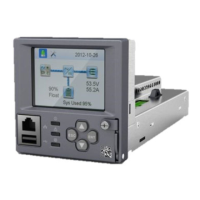Vertiv™ NetSure™ Control Unit (NCU) User Manual
3. Set the “Test Voltage Level” to the same value as the test voltage of the existing power system.
4. Using the Web Interface menus (see “Power Split Tab” on page 216), select the NCU digital input connected to the existing
systems battery test control circuit.
NOTE!
Other settings in this menu regarding “Battery Test” are inactive.
NOTE!
Battery test is controlled by the existing power system via an incoming digital signal. The system will remain at
battery test as long as this signal is active.
Low Voltage Disconnect Setup
If low voltage disconnect functions are to be used, they must be implemented in the existing power system and signals from its
control unit must be connected to the NCU.
1. Using the Web Interface menus (see “Power Split Tab” on page 216), select the NCU digital inputs connected to the low
voltage disconnect control circuits.
Temperature Compensated Battery Charge
There is no possibility to activate the “Temperature Compensated Battery Charge” function when the NCU power system is
configured for “Power Split” mode.
However, the possibility to change the “Delta Voltage” enables the NCU power system to follow the existing power system that has
the functionality to a certain limit.
Example: The “Delta Voltage” in the NCU power system is set to 1.0V. The existing power system is set to compensate 3.0 mV/cell/°C.
This means that the NCU power system can follow the temperature compensation of the existing; power system in the range of ±14
°C from the set normal battery temperature (3.0 mV x 24 cells x 14 °C = 1.008 V).
Verifying the Operation of the Power Split Feature
After programming the “Power Split” feature, verify its operation as follows.
1. In a Power Split application where the NCU power system is taking the entire load and the rectifiers in the existing power
system are all in the standby mode, use an external dry load bank of sufficient capacity to increase the load on the NCU
power system over the “POWER SPLIT CURRENT LIMIT” value.
a) Verify that the NCU power system limits the total output of its rectifiers to the current equivalent to this programmed
percentage.
b) Verify that the NCU power system lowers its output voltage by the value of the programmed “DELTA VOLTAGE”.
c) Verify that the rectifiers in the existing power system take the additional load as the load increases pass the “POWER
SPLIT CURRENT LIMIT” value.
d) Further increase the load in order to exceed the total capacity of the rectifiers in the existing power system (or shut
down some of the rectifiers in the existing power system if the capacity of the external dry load bank is not sufficient).
Verify that the NCU power system starts taking the additional load as soon as the total capacity of the rectifiers in the
existing power system is exceeded.
2. In a Power Split application where the NCU power system is taking only part of the load (operating continuously at the
current level equivalent to the programmed “POWER SPLIT CURRENT LIMIT” percentage) and the rectifiers in the existing
power system are taking the rest of the load, use an external dry load bank of sufficient capacity to increase the load in order

